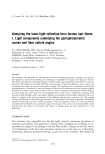266 JOURNAL OF COSMETIC SCIENCE Table I Growth of M. sympodialis and M. globosa in Different Test Preparations After Varying Incubation Times Frequency of growth (of n = 10) with M. sympodialis/incubation time (days) M. globosa/incubation time (days) Code Substance 4 11 15 18 A Antidandruff shampoo 3 7 1 B Shampoo base + 2% polidocanol 10 10 7 7 C Shampoo base + 0.5% octopirox 10 10 8 9 D Shampoo base + 1% climbazole 4 5 1 E Shampoo base 10 10 8 8 Because of slower growth, M. globosa could not be evaluated prior to day 15. Table II Results of Hair Strand Test for M. sympodialis After Four Days Hair from volunteer Shampoo A Shampoo B Shampoo C Shampoo D Shampoo E 1 + (margin) + + + + 2 0 + + 0 + (margin) 3 0 + + 0 + 4 0 + + 0 + 5 + + + 0 + 6 0 + (margin) + (margin) 0 + (margin) 7 0 + + 0 + 8 0 + + + + 9 + + + + + 10 0 + + + + Growth/total number 3/10 10/10 10/10 4/10 10/10 Margin = growth only at the margin of the suspension inoculate where there is no hair. rations A and D were significantly better than B, C, and E. It was not possible to calculatep-values for paired comparisons of test formulations with identical results in the hair strand test. For these comparisons, the McNemar test results are shown in Tables IV and V. It should also be noted that the same p-values occur for different comparisons (e.g., 0.016 or 0.031). This phenomenon results from the small number of cases and the discrete character of distribution. After ll-day incubation, the test results remained unchanged for preparations B, C, and E. The number of specimens showing growth increased to seven with A and five with D (see Table I). Therefore, the McNemar test failed to reveal statistically significant differences among the five test substances after eleven days of incubation. Results of the hair strand test for M. globosa after 18 days are shown in Table III and Figures 1 and 2. As observed with M. sympodialis, preparations A and D had a significant growth-inhibiting effect. Only in one case each was growth of M. globosa observed. The McNemar test results are shown in Table V. No significant differences were found among preparations B, C, and E. Test formulations A and D were significantly better than preparations B, C, and E. After 18 days, the hair strand test revealed the same result for test preparations A, B, D, and E. The number of specimens showing growth with
HAIR STRAND TEST 267 Table III Results of Hair Strand Test for M. globosa After 18 Days Hair from volunteer Shampoo A Shampoo B Shampoo C Shampoo D Shampoo E 1 0 + + 0 + 2 0 + + 0 + 3 0 (+) + 0 + 4 0 + 0 0 + 5 + + + 0 + 6 0 0 + (margin) 0 0 7 0 + + 0 + 8 0 + + 0 + 9 0 0 + + + 10 0 0 + 0 0 Growth/total number 1 / 10 7 / 10 9/10 1 / 10 8/10 Table IV Results of McNemar Test for M. sympodialis After Four Days (p-Values) Formulation B C D E A 0.016 0.016 1.000 0.016 B -- -- 0.031 -- C -- -- 0.031 -- D -- -- 0.031 Table V Results of McNemar Test for M. globosa After 18 Days (p-Values) Formulation B C D E A 0.031 0.008 1.000 0.016 B -- 0.625 0.070 1.000 C -- -- 0.008 1.000 D -- -- 0.016 preparation C increased from eight to nine (see Table I). The McNemar test results after 18 days were identical to those obtained after 15 days. DISCUSSION By means of the hair strand test, a new in vitro test system adapted to natural conditions in terms of inoculate, hair density, and application, it was shown that hair shampoos/ substances have different antifungal effectiveness against Malassezia yeasts, which are thought to be primarily involved in the pathogenesis of dandruff (pityriasis simplex capillitii) (5,6,10). The test was unusual in that antifungal activity was not determined directly, but indirectly after incubation of hair samples in various test preparations to assess the bioavailability of the antifungal agents and a possible depot effect. Olive oil overlaid on SPF was used instead of Dixon's agar or Leemings's medium to provide a lipophilic environment resembling the sebum-rich milieu near the scalp surface. The
Purchased for the exclusive use of nofirst nolast (unknown) From: SCC Media Library & Resource Center (library.scconline.org)


























































































